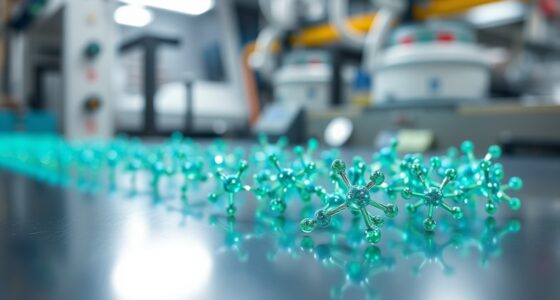Nanotech is revolutionizing waste management by enabling precise detection, fast breakdown, and efficient recycling of materials. Advanced nanomaterials and nanostructures help identify contaminants, sort waste faster, and break down complex waste compounds more thoroughly. These innovations reduce pollution and support sustainable practices. While safety and cost challenges exist, ongoing advancements aim to address them. Explore further to uncover how nanotechnology can transform waste workflows and promote a cleaner environment.
Key Takeaways
- Nanomaterials enhance waste detection accuracy and speed through sensitive, real-time sensors for chemicals, plastics, and hazardous materials.
- Nanocatalysts accelerate waste breakdown and facilitate efficient recycling of complex materials.
- Nanostructured membranes improve filtration and material recovery in waste separation processes.
- Nanotech reduces environmental pollution by enabling eco-friendly, chemical-free waste treatment methods.
- Integration of nanomaterials supports circular economy strategies through improved resource recovery and sustainable waste management.
The Role of Nanomaterials in Waste Detection
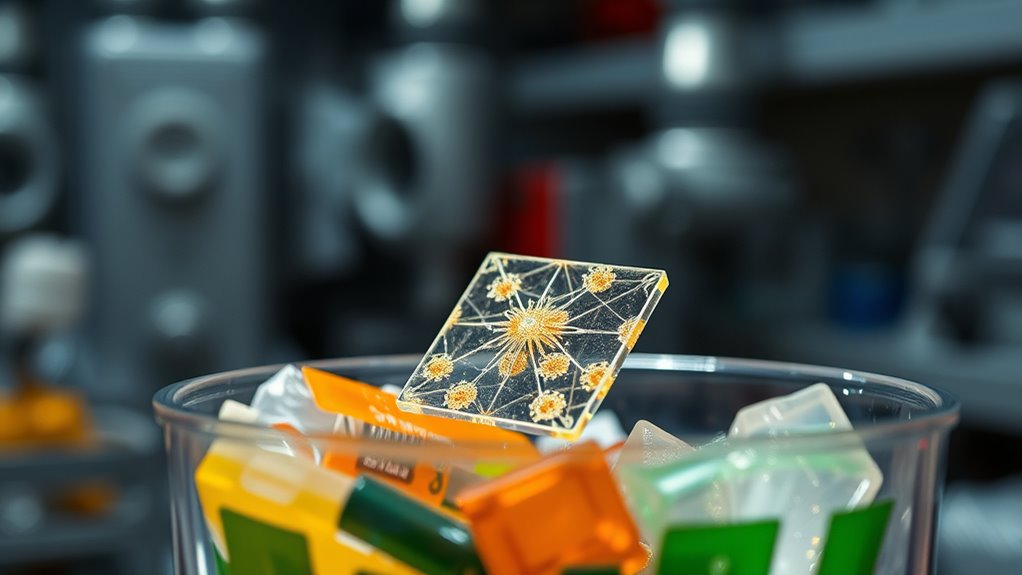
Have you ever wondered how we can detect waste more efficiently? Nanomaterials play a vital role in this process. Their tiny size and unique properties allow them to identify specific waste components with high sensitivity. For example, nanostructured sensors can detect chemicals, plastics, and hazardous materials at incredibly low concentrations. These sensors work quickly, providing real-time data that helps streamline waste sorting. Because nanomaterials can be customized for different targets, they make waste detection more accurate and efficient. This precision reduces contamination and improves recycling rates. By integrating nanomaterials into detection systems, waste management becomes faster, smarter, and more sustainable. Their ability to identify waste at the molecular level marks a significant step forward in modern recycling technology. Enhanced material durability ensures long-lasting sensors that withstand harsh environmental conditions, further advancing the effectiveness of waste detection systems.
Enhancing Sorting Processes With Nanotechnology
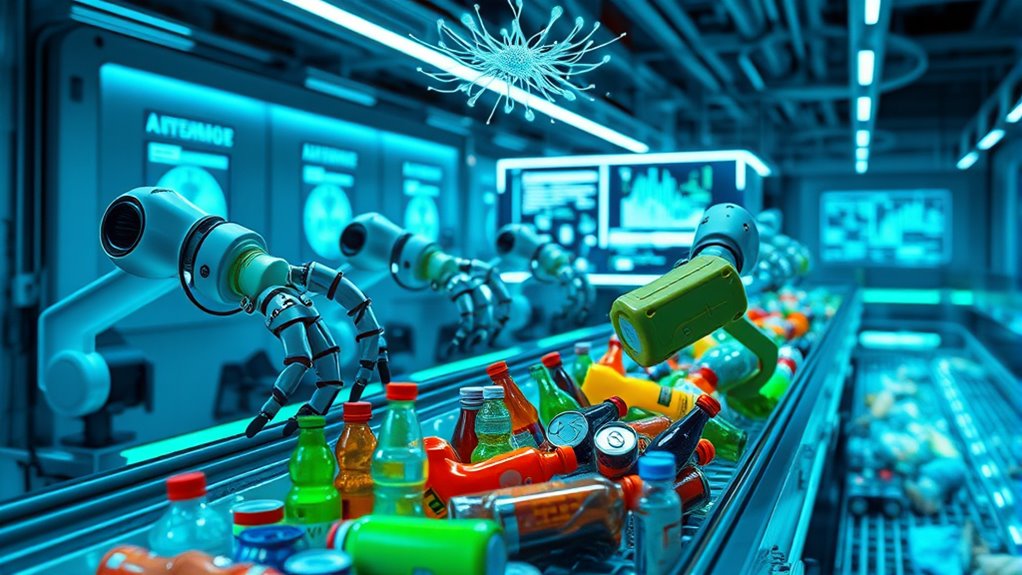
Nanotechnology is revolutionizing waste sorting by providing highly precise and efficient tools that can distinguish different materials at the microscopic level. You can now implement nanosensors that detect specific chemical or physical properties unique to plastics, metals, or organics, allowing for faster and more accurate separation. These sensors improve the sorting process by reducing contamination and increasing the purity of recycled materials. Additionally, nanoscale filters can target and isolate tiny particles that traditional methods overlook, enhancing overall efficiency. This technology minimizes waste loss and lowers processing costs. As a result, waste management facilities become more effective at sorting diverse waste streams, ensuring that recyclable materials are properly separated and recovered, ultimately promoting more sustainable recycling practices.
Nanotech-Driven Approaches to Waste Breakdown

Nanotech offers innovative ways to break down waste more efficiently using nanoparticles that accelerate degradation processes. Catalytic nanomaterials can speed up recycling by transforming materials into reusable forms, reducing time and energy. Additionally, enzymatic nanotech applications harness specific enzymes at the nanoscale to target and decompose waste with high precision.
Nanoparticles for Waste Degradation
Nanoparticles have emerged as powerful tools in waste degradation because of their ability to accelerate chemical reactions and target complex pollutants at a microscopic level. They enhance the breakdown of hazardous substances by providing a high surface area, which speeds up reactions that would otherwise take much longer. You can deploy metal-based nanoparticles, such as iron or titanium, to catalyze the degradation of organic waste and toxic chemicals. These particles can penetrate difficult-to-reach areas within waste matrices, ensuring more thorough treatment. Additionally, nanoparticles can be engineered to selectively bind or react with specific contaminants, making the process more efficient. For example, the use of Celebrity Lifestyle Insights can inspire innovative approaches to sustainable waste management by integrating lifestyle trends with advanced nanotech solutions. As a result, you can achieve faster, more complete waste breakdown, reducing environmental impact and facilitating safer disposal or recycling.
Catalytic Nanomaterials in Recycling
Catalytic nanomaterials have revolutionized recycling processes by enabling more efficient breakdown of complex waste materials. These tiny catalysts accelerate chemical reactions, making it easier to recover valuable resources. You can leverage them to target specific pollutants or plastics, enhancing overall recycling effectiveness. Their high surface area boosts catalytic activity, reducing energy consumption and processing time. Additionally, they enable the development of selective catalysts that minimize byproducts and waste. With nanotech, you can create durable, reusable catalysts that withstand harsh conditions, increasing sustainability. This innovation opens doors to cleaner, faster recycling methods. Hyundai Tuning
Enzymatic Nanotech Applications
By integrating enzymes with nanotechnology, researchers are creating highly efficient waste breakdown systems that outperform traditional methods. These enzymatic nanotech applications utilize nanoscale enzymes, which have increased surface area and reactivity, to accelerate the degradation of plastics, textiles, and organic waste. You can imagine how these tiny catalysts work faster and more effectively, breaking down complex molecules into simpler, harmless substances. This approach reduces the time and energy needed for waste processing, making recycling more sustainable. Additionally, nanotech-enhanced enzymes can be tailored to target specific waste types, improving selectivity and efficiency. The development of environmentally friendly materials further supports sustainable waste management practices. As a result, enzymatic nanotech applications hold great promise for transforming waste management, minimizing environmental impact, and advancing circular economy practices.
Improving Recycling Efficiency Using Nanostructures

Advancements in nanostructures are revolutionizing recycling processes by enabling more precise separation and detection of materials. These tiny structures enhance the ability to identify and extract specific plastics, metals, or contaminants quickly and accurately. By incorporating nanomaterials into sorting equipment, you can considerably improve throughput and purity. Nanostructures increase surface area, boosting interactions with targeted materials and making detection more sensitive. They also enable the development of smarter sensors that can distinguish different substances in real-time. With these innovations, you’ll see faster processing, less waste, and higher-quality recyclables.
- Enhanced selectivity for different materials
- Faster, real-time detection capabilities
- Improved purity and sorting accuracy
Environmental Benefits of Nanotechnology in Waste Management
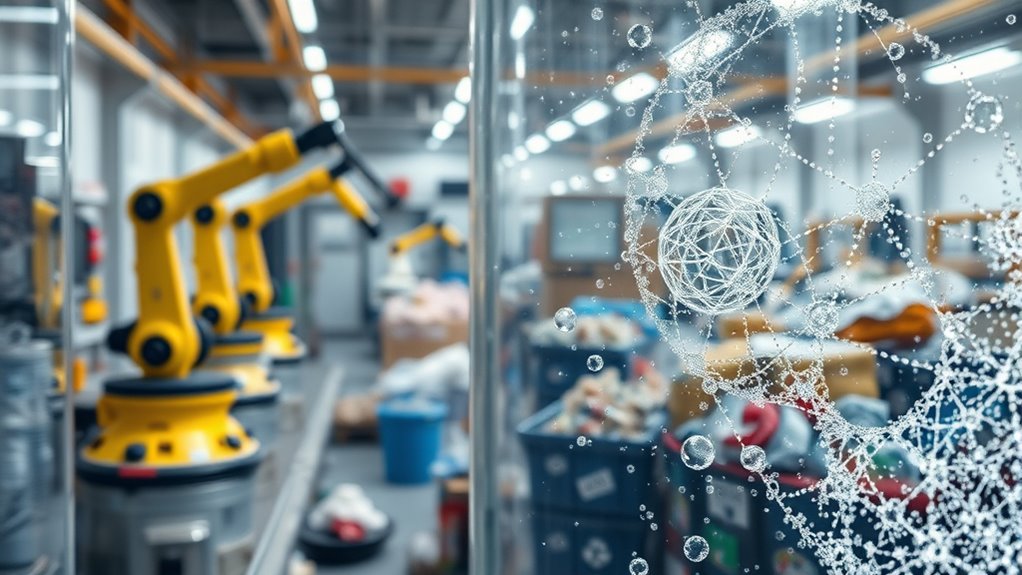
Nanotechnology’s role in enhancing recycling efficiency already shows promise, but its environmental benefits extend further. By enabling more precise detection and separation of waste materials, nanotech reduces the need for harsh chemicals and energy-intensive processes. This leads to less pollution and lower greenhouse gas emissions during waste treatment. Nanomaterials can also improve pollutant breakdown, making hazardous waste safer to handle and dispose of. Additionally, nanotech innovations promote the development of biodegradable materials, decreasing long-term landfill accumulation. You’ll find that these advances help conserve natural resources by enabling the reuse of materials that were previously difficult to recycle. For example, the distinctive odor management properties of nanomaterials can help detect and eliminate unpleasant smells associated with waste, improving waste processing environments. Overall, nanotechnology’s applications contribute to a cleaner environment, minimize ecological disruption, and support sustainable waste management practices.
Challenges and Safety Considerations in Nanotech Applications
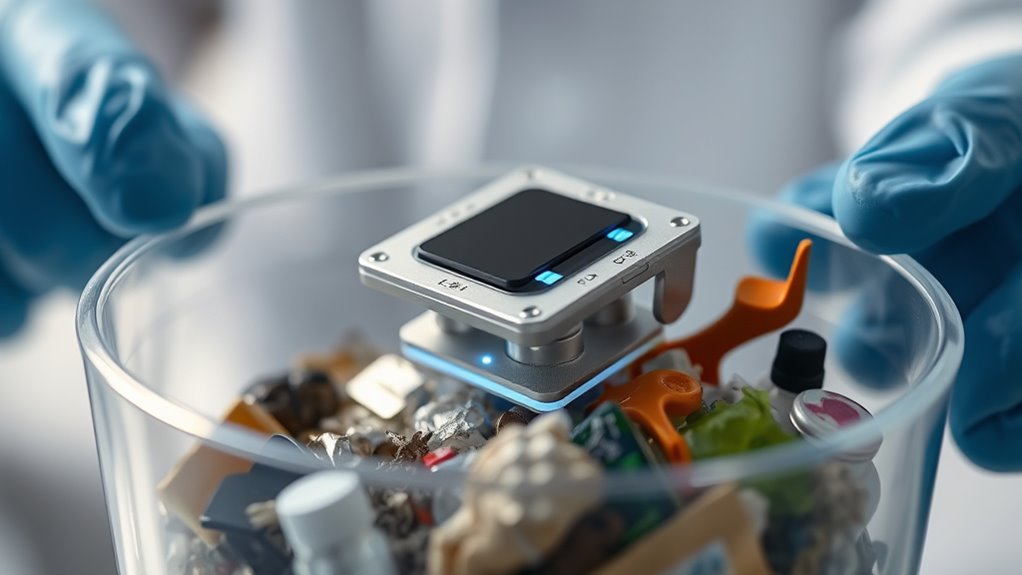
While nanotechnology offers promising solutions for waste management, it also presents significant challenges and safety concerns that must be addressed. You need to take into account the potential environmental and health risks associated with nanomaterials, such as toxicity and bioaccumulation. Proper regulation and oversight are vital to prevent unintended consequences. Additionally, manufacturing processes can be complex and costly, making widespread adoption difficult. There’s also the risk of nanoparticle release into ecosystems, which could harm wildlife and humans. To mitigate these issues, focus on developing safe, sustainable, and controllable nanotech practices. Key concerns include:
Nanotech waste solutions require careful regulation to prevent environmental and health risks.
- Toxicity and health impacts of nanomaterials
- Environmental release and contamination
- Regulatory gaps and safety protocols
- The use of eco-friendly materials can help reduce environmental impact and improve safety standards.
Case Studies of Nanotech Implementation in Recycling Facilities

Across various recycling facilities worldwide, the integration of nanotech has begun transforming waste processing by enhancing efficiency and precision. For example, some plants now use nanomaterial-based sensors to detect specific contaminants in plastics and metals, allowing for faster sorting. In South Korea, researchers implemented nanostructured membranes that improve filtration, increasing recovery rates of valuable materials. Similarly, certain facilities employ nanocatalysts to break down complex waste compounds more efficiently, reducing processing time and energy consumption. These case studies demonstrate how nanotechnology can optimize resource recovery and reduce waste. Additionally, advances in fraud detection techniques are aiding in the secure handling of transaction data in waste management systems to prevent cyber threats. As you explore these examples, you’ll see that nanotech’s real-world applications are already making recycling more effective, setting the stage for broader adoption in the industry.
Future Perspectives and Innovations in Nanomaterials
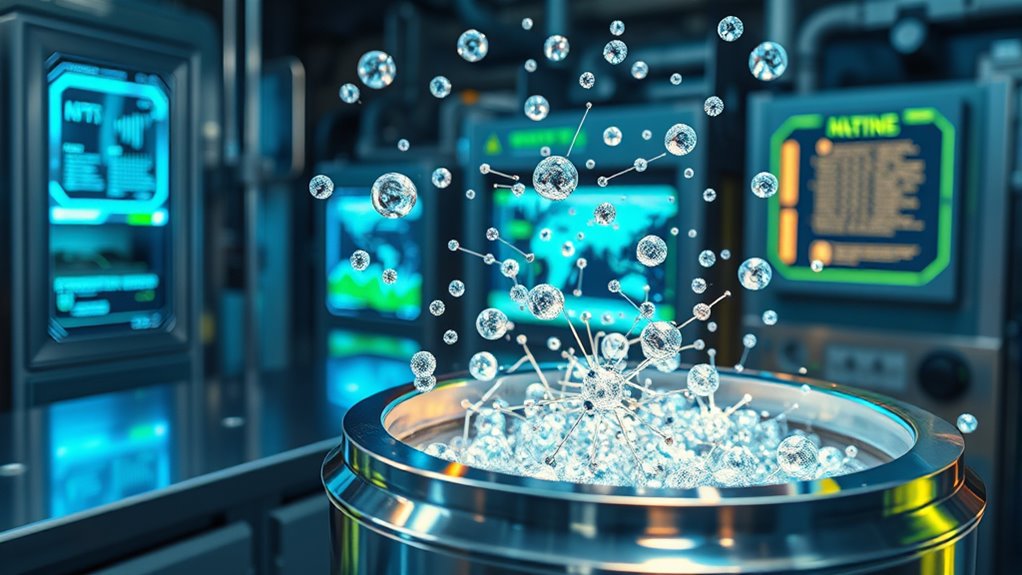
Looking ahead, advancements in nanomaterial designs will enable more efficient waste detection and separation processes. Smart technologies using nanomaterials will make recycling systems more responsive and automated. These innovations promise sustainable solutions that could transform waste management practices globally. Moreover, integrating creative practice principles such as experimentation and adaptation can accelerate the development of innovative nanotechnologies in this field.
Advanced Nanomaterial Designs
Advancements in nanomaterial design are poised to revolutionize waste management and recycling by enabling more efficient, selective, and durable solutions. Researchers are developing novel nanostructures that target specific waste components, improving separation and recovery processes. These designs include functionalized nanoparticles with tailored surface properties, self-healing nanomaterials that extend lifespan, and hybrid composites that combine multiple functionalities. Such innovations can enhance catalyst efficiency, increase resistance to corrosion, and enable better mechanical performance. You’ll see nanomaterials that:
- Offer precise targeting of contaminants through customizable surface chemistry
- Improve durability and lifespan of waste treatment equipment
- Enable multifunctional capabilities, like combined filtration and catalysis
- Incorporate market research to identify emerging needs and optimize nanomaterial applications
These advances pave the way for smarter, more sustainable waste management practices.
Smart Waste Detection Technologies
Building on recent progress in nanomaterial design, smart waste detection technologies are emerging as game-changers for efficient waste management. You can now deploy nanosensors that quickly identify specific waste components, such as plastics or hazardous materials, with high sensitivity. These sensors provide real-time data, enabling you to optimize collection routes and improve sorting accuracy. The integration of nanomaterials enhances sensor durability, ensuring long-term performance even in harsh environments. You might also leverage nanostructured coatings that change color or emit signals when encountering certain waste types, simplifying manual or automated detection. As these technologies evolve, you’ll benefit from faster, more reliable waste sorting systems that reduce contamination and increase recycling rates, ultimately making waste management more sustainable and resource-efficient. Additionally, understanding that air quality can be significantly impacted by waste-related pollutants emphasizes the importance of these innovative detection methods.
Sustainable Recycling Solutions
As nanomaterials continue to evolve, they offer promising opportunities to transform recycling processes into more sustainable and efficient systems. These innovations can reduce waste, lower energy consumption, and improve material recovery rates. You might see nanotech-enhanced sensors that detect contaminants more accurately, enabling better sorting of recyclables. Additionally, nanomaterials can create stronger, more durable recycling containers that last longer and are easier to reuse. Researchers are also developing nanocatalysts that accelerate chemical recycling, making it faster and more eco-friendly.
- Improved sorting accuracy with nanosensors
- Durable, eco-friendly nanocomposite containers
- Nanocatalysts for efficient chemical recycling
Integrating Nanotech With Circular Economy Strategies

Integrating nanotechnology with circular economy strategies offers a promising way to enhance waste management and recycling efforts. Nanotech enables the development of advanced materials and processes that improve resource recovery and reduce waste. For example, nanomaterials can boost the efficiency of sorting systems or facilitate the breakdown of complex waste compounds. By combining nanotech with circular economy principles, you can create closed-loop systems that minimize raw material extraction and maximize reuse. This integration promotes sustainable practices, reduces environmental impact, and supports economic resilience. The table below highlights some key ways nanotech contributes to circular economy strategies:
| Strategy | Nanotech Application |
|---|---|
| Material Recovery | Nanomaterials improve separation tech |
| Recycling Efficiency | Catalysts boost waste breakdown |
| Product Longevity | Nanocoatings extend product life |
| Waste Minimization | Nanomembranes enable selective filtration |
Frequently Asked Questions
What Are the Potential Health Risks of Nanomaterials in Waste Management?
You should be aware that nanomaterials in waste management pose health risks, such as respiratory issues if inhaled, skin irritation from contact, and potential toxicity if they enter your bloodstream. These tiny particles can penetrate cells and tissues, causing inflammation or oxidative stress. To stay safe, always use proper protective gear, follow safety protocols, and stay informed about ongoing research on nanomaterials’ health impacts.
How Cost-Effective Is Nanotechnology Compared to Traditional Waste Processing Methods?
You might think nanotech is too costly, but surprisingly, it can be more cost-effective than traditional methods. By enhancing efficiency, reducing waste, and speeding up processes, nanotechnology saves money in the long run. While initial investments seem high, the improved performance and less need for extensive resources quickly offset those costs. So, don’t dismiss it too soon—you could end up saving more than you’d expect.
Are There Any Regulatory Standards for Nanomaterials in Recycling Facilities?
Yes, there are regulatory standards for nanomaterials in recycling facilities. You need to adhere to guidelines set by organizations like the EPA and OSHA, which address handling, exposure limits, and disposal of nanomaterials. These standards aim to protect workers and the environment. It’s important that you stay updated on evolving regulations, as nanotechnology’s use in recycling is rapidly advancing, and compliance ensures safe and responsible practices in your facility.
Can Nanotech Be Used to Manage Hazardous or Radioactive Waste?
Yes, nanotech can help manage hazardous and radioactive waste by enabling targeted containment and cleanup. You can use nanomaterials to adsorb toxic substances or neutralize radioactivity, making disposal safer. While promising, you should be aware that the technology is still developing, and safety standards are evolving. Implementing nanotech in this field could revolutionize waste management, but it requires careful regulation and ongoing research to guarantee environmental and human health are protected.
What Are the Long-Term Environmental Impacts of Nanomaterial Disposal?
You might not realize it, but disposing of nanomaterials could pose long-term environmental risks. These tiny particles can accumulate in ecosystems, potentially harming plants, animals, and water sources. Over time, they might disrupt natural processes or cause unforeseen toxicity. It’s essential that you support responsible disposal methods and ongoing research to understand and mitigate these impacts, ensuring nanotechnology benefits without compromising environmental health.
Conclusion
By embracing nanotech in waste management, you’re opening superpowers that could transform trash into treasure overnight. Imagine a world where waste disappears instantly, recycling becomes effortless, and the environment breathes a sigh of relief. With nanomaterials leading the charge, you’re on the brink of a revolution so incredible it’ll make today’s efforts look like child’s play. Get ready—your role in this epic change is more essential than ever!



